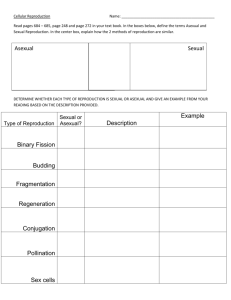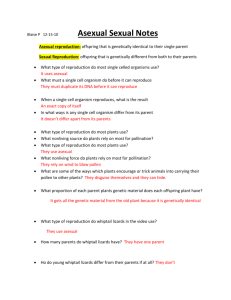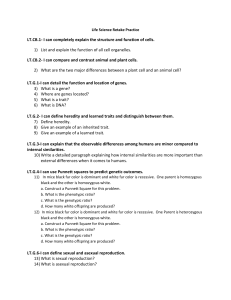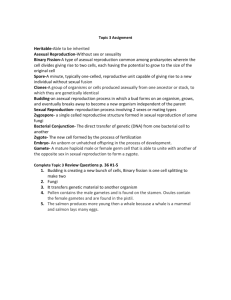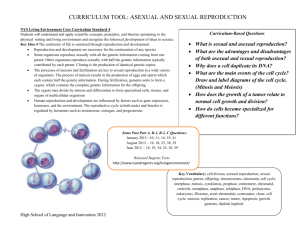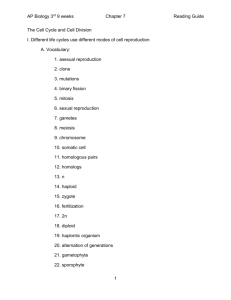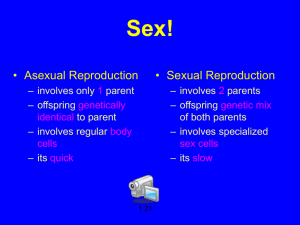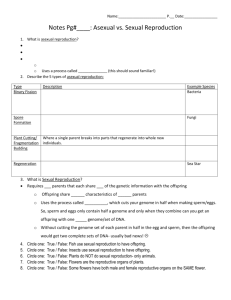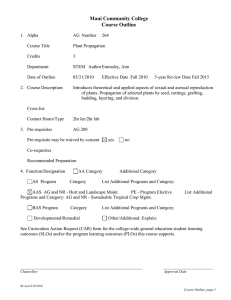Asexual Reproduction
advertisement
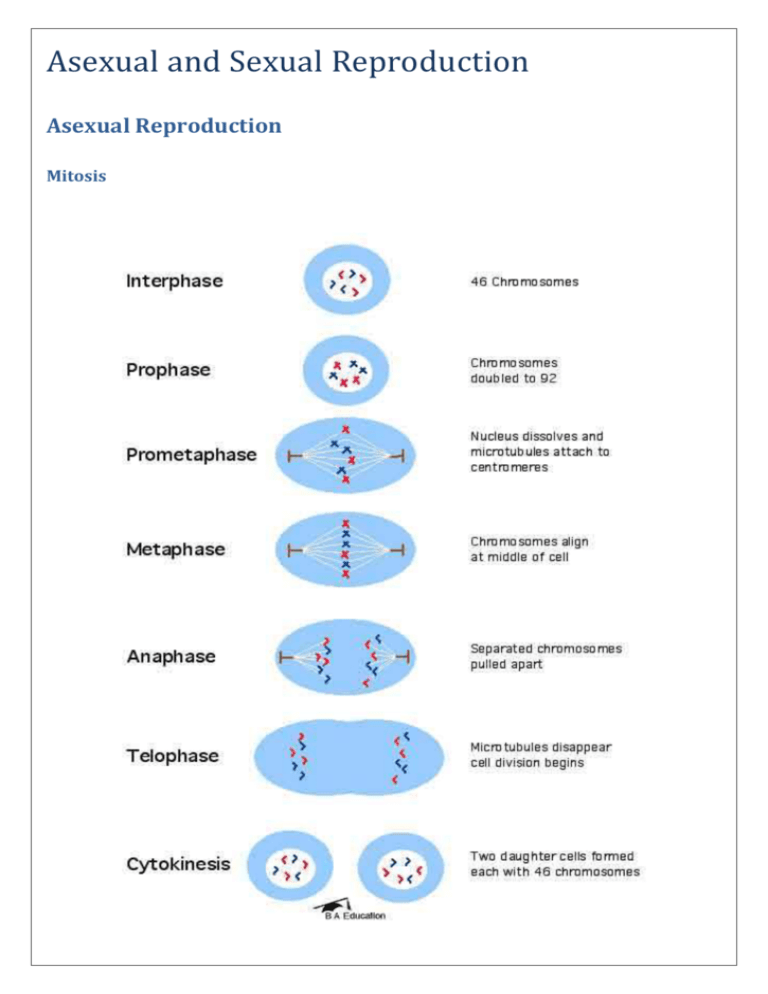
Asexual and Sexual Reproduction Asexual Reproduction Mitosis Bacteria A copy of the DNA is made. Splits into two separate parts of the cell (Cleavage forms) Cell splits to form identical daughter cells Fungi A aerial hypha is grown A sporangium grows Spores are made in the sporangium by mitosis The sporangium dries out and breaks, releasing the spores Flowering plant (Potato) An underground stem develops and becomes swollen to forma stem tuber New shoots can develop from the dormant auxillary buds of the tuber These new shoots form a new plant o Farmer’s use the fact that all the potatoes produced asexually are identical and therefore provide uniform quality in the field. Advantages of asexual reproduction Simple and fast Only one parent needed Rapid spreading Plants – no need for agents of pollination or seed dispersal Disadvantages of asexual reproduction Genetically identical – no variation Diseases can spread rapidly Overcrowding Sexual Reproduction The fusion of haploid male and female gametes o Animals Male – Sperm Female – Ovum o Plants Male – Pollen Female – Ovule Male gamete usually moves to fertilize female gamete A zygote is formed Mitosis occurs in the gamete to form the new organism Advantages of sexual reproduction Increased variation – Better chance of survival in changing conditions Offspring are more vigorous (stronger) Disadvantage of sexual reproduction Two parents are required Young may be vulnerable and take a long time to develop into adults Plants: Agents of pollination and dispersal may be needed Meiosis Only occurs in the reproductive tissues of organisms o Animals Male: Testis Female: Ovaries o Plants Male: Stamens Female: Ovaries Cells involved: Parent cells o Diploid o Full number of chromosomes Daughter cells o Diploid o Full number of chromosomes Gametes o Haploid o Half the number of chromosomes Cancer and carcinogens Cancer When a mutation in the DNA of a cell occurs, the cell may start to reproduce uncontrollably and fail to differentiate. Tumours A group of cancerous cells is called a tumour. There are two types: Benign o Shows no tendency to invade surrounding tissue o Often easy to surgically remove and can be cured o Are still dangerous due to growth Can crush or displace healthy tissue Malignant o Invade surrounding tissue o Can invade bloodstream sending cancerous cells all over the body o Secondary tumours then occur o Difficult to treat Carcinogens Factors which increase the risk of cancer. Examples: X-Rays, Gamma rays, alpha particles and beta particles from nuclear radiation Ultraviolet light Asbestos dust Fungal poisons Hydrocarbons Alcohols Smoking and cancer Tobacco smoke contains tar, a carcinogen. Smoking is the biggest single cause of lung cancer. Smokers expose themselves to high concentrations of this smoke for prolonged periods. o This gives them a high risk of getting cancer. o Non-smokers are also susceptible due to inhaling second-hand smoke. Industrial causes Industrial area’s have higher levels of carcinogens in the atmosphere. There are risks of the radioactive gas, Radon, building up in houses near granite rock. Artificial Propagation of Plants A breeder can use asexual methods to produce perfect copies or clones of a parent plant. Cuttings A stem is cut off a living plant It may be planted straight into the soil, or first kept in water o Rooting compounds can be used to stimulate root growth Micropropagation Many more new plants can be propagated from a single parent plant. This is achieved by using totiponent plant cells o Totipotency is the property of a plant cell that allows it to generate an entirely new plant from that one cell. o These cells are usually taken from the tip of a growing shoot. Process The cells are seperated and put into a culture medium that contains plant growth substances The growth substances stimulate the mitotic division of the totipotent cells o Small roots develop o It is now called a plantlet The plantlet is placed in a new culture medium that stimulates the growth of the shoot. Once large enough, these plantlets can be planted in soil and be allowed to grow like a normal plant. ASEXUAL PROPAGATION OF CROP PLANTS Advantages of asexual propagation Produce genetically identical plants o Growth rate, harvest time, quality, size and the amount of produce are all the same. Disadvantages of asexual propagation All are susceptible to the same diseases, bacteria, fungi and other plant pests o A farmer can lose his entire crop very quickly Farmers are unable to improve the characteristics of their plants SEXUAL PROPAGATION OF CROP PLANTS Advantages of sexual propagation Genetically different o Natural selection will result in a high proportion of plants with characteristics of high yield and disease resistance. Disadvantages of sexual propagation Slow process Many generations of plants are needed to produce the plants with the best characteristics Pollination is very laborious (as it may need to be done by hand)
